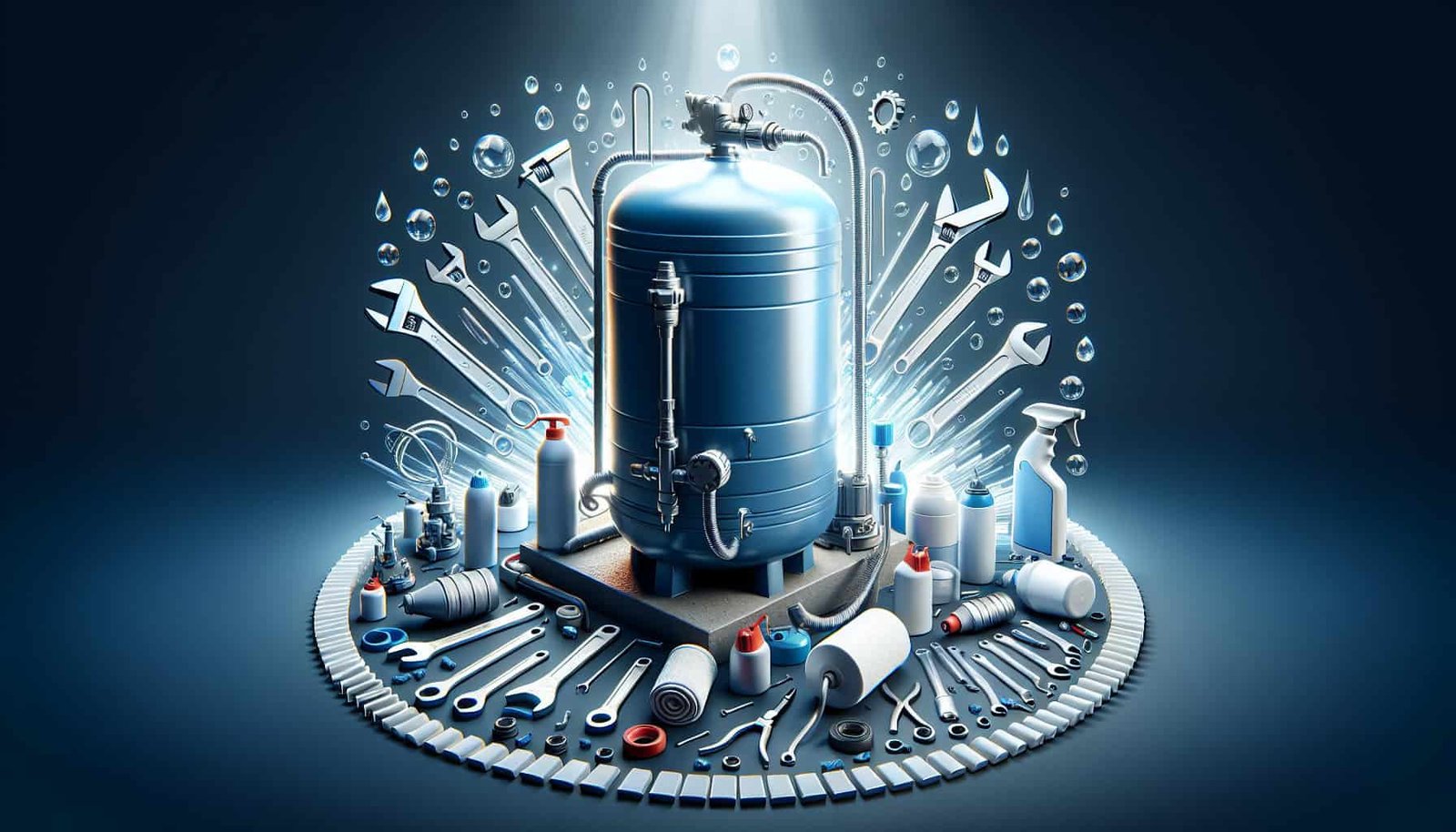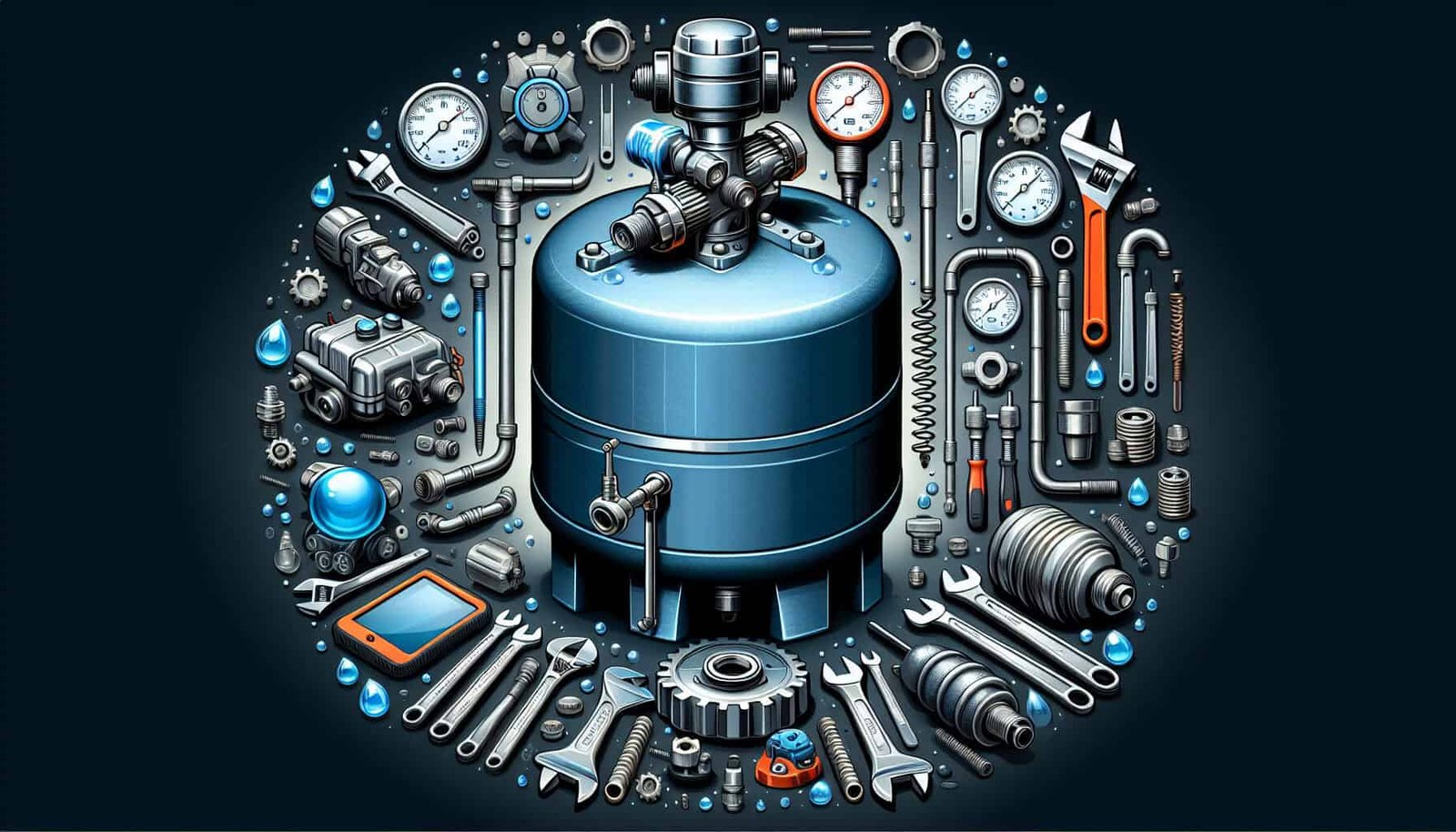If you rely on well water for your daily needs, it is crucial to ensure the safety and proper maintenance of your well water pressure tank. By understanding and following the recommended maintenance procedures, you can safeguard your well against potential safety issues. In this article, we will explore the importance of maintaining your well water pressure tank and discuss some key steps to help you keep it in excellent condition.
Importance of Well Water Pressure Tank Maintenance
Maintaining your well water pressure tank is crucial to ensuring the efficiency, safety, and longevity of your well water system. A well water pressure tank is responsible for regulating the water pressure in your household, preventing frequent pump cycling, and providing a steady and reliable water supply. Without regular maintenance, issues such as leaks, low water pressure, and even contamination can arise, leading to costly repairs and potential health hazards. Therefore, understanding the role of well water pressure tanks, common safety issues, and the importance of regular maintenance is essential for every well owner.
Understanding the Role of Well Water Pressure Tanks
Well water pressure tanks play a vital role in maintaining a continuous water supply and controlling the pressure within your home’s plumbing system. When the well pump is activated, it fills the pressure tank with water, compressing air inside the tank. This compressed air acts as a cushion, allowing the pressure tank to store water under pressure. As you use water in your home, the pressure inside the tank decreases, causing the pump to kick on and replenish the tank. This balance of filling and emptying the pressure tank prevents the pump from continuously running and ensures a stable water pressure throughout your household.
Common Safety Issues Associated with Well Water Pressure Tanks
While well water pressure tanks are generally reliable, certain safety issues can arise if they are not properly maintained. One common problem is the buildup of mineral deposits or sediment inside the tank. Over time, these deposits can corrode the tank’s interior, leading to leaks or contamination of the water supply. Additionally, a malfunctioning pressure tank can cause low water pressure, excessive cycling of the pump, and even electrical hazards if the system is not properly grounded. Regular maintenance helps identify and address these safety issues before they escalate and pose a risk to your well and household.
Why Regular Maintenance is Essential
Regular maintenance of your well water pressure tank is essential for multiple reasons. Firstly, it ensures the system’s longevity by preventing major issues that may require costly repairs or even the replacement of the entire tank. Secondly, it helps maintain the safety and quality of your water supply, preventing the risk of contamination. Lastly, regular maintenance allows you to maximize the efficiency of your well water system, reducing energy consumption and lowering utility bills. By investing time and effort into proper maintenance, you can enjoy a reliable and safe water supply for years to come.
Choosing the Right Well Water Pressure Tank
Selecting an appropriate well water pressure tank is the first step in ensuring a well-functioning water system. Here are some considerations to keep in mind when choosing the right pressure tank for your needs.
Considerations for Selecting an Appropriate Tank Size
One of the essential factors to consider is the tank size. The size of the pressure tank should be based on your household’s water usage patterns. If you have a larger household or frequently use high-demand appliances such as dishwashers and washing machines, a larger tank size may be necessary to maintain optimal water pressure. On the other hand, smaller households with lower water consumption can opt for smaller tanks. Consulting with a knowledgeable professional or a well water contractor can help you determine the appropriate tank size for your specific situation.
Exploring Different Tank Materials
Well water pressure tanks are available in various materials, including steel, composite, and fiberglass. Each material has its pros and cons, and your choice should be based on factors such as durability, corrosion resistance, and cost. Steel tanks are durable but may be prone to corrosion over time. Composite tanks are lightweight, affordable, and resistant to rust, but they may not be as durable as steel tanks. Fiberglass tanks offer excellent corrosion resistance but are more expensive than other options. Understanding the characteristics of each material will help you make an informed decision.
Understanding Your Water Usage Needs
Before selecting a pressure tank, it is essential to assess your household’s water usage needs. Consider factors such as the number of occupants, daily water usage, and peak demand periods. Having this information will help you determine the appropriate tank size and ensure that it can meet the demands of your household without compromising water pressure. By choosing a tank that aligns with your specific usage needs, you can avoid issues such as low water pressure or excessive cycling of the pump.
Consulting with Professionals
Choosing the right well water pressure tank can be overwhelming, especially with the wide array of options available. To make an informed decision, it is advisable to consult with professionals such as licensed well contractors or reliable plumbers. These professionals have the expertise and experience to guide you through the selection process, taking into account factors specific to your well water system. By seeking their advice, you can ensure that the pressure tank you choose is suitable for your needs and meets safety standards.

Safety Measures during Installation and Setup
Proper installation and setup of your well water pressure tank are crucial for safety and functionality. Here are some safety measures to keep in mind during the installation process.
Working with Licensed Well Contractors
When it comes to installing or replacing a well water pressure tank, it is best to work with licensed well contractors. These professionals have the knowledge and expertise to handle the installation safely, ensuring compliance with local codes and regulations. Attempting to install the pressure tank yourself without the necessary skills and experience can be risky and may lead to safety hazards. Licensed contractors will ensure that all necessary safety precautions are taken during the installation process, giving you peace of mind and a well-functioning system.
Proper Placement and Positioning of the Tank
The placement and positioning of your well water pressure tank are essential for safety and efficiency. The tank should be installed in a clean, dry, and well-ventilated area. It should also be positioned on a stable surface to prevent it from toppling over or leaning. Additionally, the tank should be located away from any potential sources of damage, such as direct sunlight, extreme temperatures, or corrosive chemicals. Consulting with a professional installer will ensure that the tank is placed in an optimal location, minimizing the risk of accidents and maximizing its lifespan.
Appropriate Anchoring and Support
To prevent the pressure tank from shifting or tipping over, it is crucial to provide proper anchoring and support. The tank should be securely anchored to prevent movement during operation. This is especially important in areas prone to earthquakes or high winds. The installer should use appropriate straps or brackets designed for securing pressure tanks and ensure that they are correctly attached to the tank and the mounting surface. Proper anchoring and support will help maintain the tank’s stability and prevent potential accidents or damage.
Connecting to the Well Water System
Connecting the well water pressure tank to the rest of your water system requires careful attention to ensure safety and functionality. It involves making the proper connections between the tank, the well pump, and the plumbing system. All connections should be tight and leak-free to prevent water loss or potential contamination. It is advisable to use high-quality plumbing fittings and materials to ensure durability and reliability. Properly connecting the pressure tank to the well water system will help maintain optimal water pressure and prevent issues such as leaks or fluctuating pressure.
Ensuring Proper Ventilation
Well water pressure tanks require appropriate ventilation to prevent the accumulation of moisture and promote airflow. Inadequate ventilation can lead to condensation inside the tank, increasing the risk of corrosion and potentially contaminating the water supply. During installation, ensure that the tank is not placed in an enclosed space without proper ventilation. Adequate airflow around the tank helps dissipate heat, reduces the risk of condensation, and maintains the integrity of the tank. Installing the tank in a well-ventilated area or using ventilation accessories recommended by the manufacturer will help ensure that your system operates efficiently and remains safe.
Regular Inspection and Maintenance
Regular inspection and maintenance of your well water pressure tank are essential to identify and address any issues before they worsen. By following a comprehensive inspection schedule, you can prevent major problems and maintain the optimal performance of your well water system.
Creating a Well Water Pressure Tank Inspection Schedule
Establishing a routine inspection schedule for your pressure tank is crucial. Depending on the manufacturer’s recommendations and your specific needs, inspections should be conducted at least once a year or as advised by a professional. During these inspections, you should thoroughly examine the tank for any signs of damage, leaks, or corrosion. Additionally, it is essential to monitor pressure levels and check the functionality of electrical components. Creating a maintenance calendar or utilizing mobile apps as reminders can help you stay on top of your inspection schedule and ensure that no inspections are missed.
Checking for Leaks and Structural Integrity
During inspections, it is crucial to check for any signs of leaks and assess the tank’s structural integrity. Inspect the tank’s exterior for any visible cracks, corrosion, or damage. Additionally, closely examine fittings, seals, and connections for any signs of leakage. Even small leaks can worsen over time, leading to water damage and compromising the tank’s functionality. If you notice any leaks or structural issues, it is important to address them promptly by contacting a professional well contractor or plumber.
Monitoring Pressure Levels
Monitoring pressure levels is an essential aspect of pressure tank maintenance. Proper pressure regulation is crucial to prevent issues such as water hammer, low water pressure, or excessive cycling of the pump. During inspections, use a pressure gauge to measure the pressure inside the tank. Compare the readings against the manufacturer’s recommended pressure range to ensure that the tank is operating within the designated parameters. If you notice any significant deviations from the recommended range, it may indicate a problem that requires further investigation by a professional.
Inspecting Electrical Components
Well water pressure tanks often contain electrical components that require regular inspection and maintenance. These components include pressure switches, control panels, and wiring. Inspect the connections, wiring, and electrical components for any signs of wear, damage, or loose connections. It is advisable to turn off the power supply before inspecting or performing any maintenance on electrical components to ensure your safety. If you notice any electrical issues or abnormalities, it is essential to contact a licensed electrician or well contractor to assess and address the problem.
Maintaining Water Quality
Maintaining water quality is a critical aspect of well water pressure tank maintenance. Regular inspections should include monitoring the quality of your well water. Conducting periodic well water testing can help identify any contamination issues or changes in water composition. If you notice any changes in water quality, such as odor, discoloration, or unusual taste, it may indicate a problem that requires further investigation and treatment. Addressing water quality issues promptly will ensure the safety and purity of your water supply.

Correcting Common Well Water Pressure Tank Issues
Well water pressure tanks can experience various issues that can affect their functionality and efficiency. By promptly addressing these common issues, you can prevent further damage and maintain a well-performing system.
Dealing with Low Water Pressure
Low water pressure is a common issue that can arise due to various factors, including a malfunctioning pressure tank. If you notice a decrease in water pressure throughout your household, it is essential to check the pressure tank. Ensure that the tank’s pressure settings are correct and that it is functioning within the recommended pressure range. If adjusting the pressure settings does not resolve the issue, it may indicate a problem with the tank itself or other components of the well water system. Contacting a professional well contractor or plumber will help diagnose the problem and perform the necessary repairs.
Addressing Excessive Cycling
Excessive cycling of the well pump is another common issue that can be attributed to a malfunctioning pressure tank. If the pump frequently turns on and off, it can lead to increased wear and tear on the system and reduced efficiency. Excessive cycling can result from incorrect pressure settings, a ruptured diaphragm in the tank, or a faulty pressure switch. Inspecting these components and ensuring they are functioning properly will help address the issue. If you are unsure how to perform these checks or if the problem persists, it is advisable to consult with a professional to prevent further damage.
Troubleshooting Pressure Switch Problems
Pressure switches are responsible for signaling the pump to turn on or off based on the water pressure inside the tank. If the pressure switch malfunctions, it can cause issues such as frequent pump cycling or failure to maintain appropriate water pressure. Inspecting the pressure switch for any visible damage, loose connections, or improper calibration is essential. If you suspect a faulty pressure switch, it is advisable to consult with a professional well contractor or electrician to ensure proper troubleshooting and repairs.
Fixing Leaks and Pipe Damage
Leakage in the well water system can lead to a loss of water pressure, increased energy consumption, and potential water damage. Inspect the pressure tank, plumbing connections, and pipes for any signs of leakage, such as water stains, dampness, or dripping. Addressing leaks promptly is crucial to prevent further damage to the system and maintain the integrity of your water supply. If you discover any leaks, contact a professional well contractor or plumber to assess and repair the issue.
Replacing Faulty Components
Over time, various components of the well water pressure tank may become worn out or faulty. These can include components such as the pressure switch, pressure gauge, or tank fittings. If these components are not functioning correctly, they can compromise the efficiency and safety of your well water system. During inspections, identify any faulty components and replace them with high-quality replacements recommended by the manufacturer. Working with professionals ensures that the replacements are properly installed and that your system operates optimally.
Ensuring Electrical Safety
As well water pressure tanks often contain electrical components, ensuring electrical safety is vital. Following proper electrical safety measures and maintenance practices will help prevent accidents and ensure the reliability of your system.
Understanding Electrical Hazards
Electricity can pose significant hazards if not handled properly. Electrical shocks, fires, or damage to the well water system can result from mishandling electrical components or failing to observe electrical safety precautions. It is important to be aware of the potential electrical hazards and take necessary safety measures when inspecting or performing maintenance on your well water pressure tank. Avoid touching electrical components without turning off the power supply, use appropriate personal protective equipment, and consult with a licensed electrician for any electrical concerns or repairs.
Proper Grounding of the Pressure Tank System
Proper grounding of the well water pressure tank system is crucial for electrical safety. Grounding provides a safe path for electrical currents to dissipate in case of a malfunction or electrical surge. It helps prevent electrical shock and reduces the risk of electrical fires. During installation or maintenance, ensure that the system is properly grounded according to local electrical codes and regulations. It is advisable to consult with a licensed electrician or well contractor for guidance on proper grounding techniques and requirements.
Maintaining GFCI Protection
Ground Fault Circuit Interrupter (GFCI) protection is another critical safety measure when dealing with electrical components in the vicinity of your well water pressure tank. GFCI outlets or circuit breakers are designed to detect any imbalances in electrical current and rapidly shut off power to prevent electrical shocks. Install GFCI outlets or ensure that the electrical circuit serving the pressure tank is appropriately protected by GFCI circuit breakers. Regularly test GFCI outlets or circuit breakers to ensure their functionality and replace any faulty devices immediately.
Electrical Maintenance Best Practices
To ensure the safety and reliability of your well water pressure tank system, it is important to follow electrical maintenance best practices. Regularly inspect electrical connections for any signs of wear, damage, or loose connections. Keep the electrical components clean and free from dust or debris, as these can cause malfunctions or increase the risk of electrical fires. If you notice any unusual sounds, smells, or behavior from electrical components, such as buzzing or sparking, turn off the power supply and contact a licensed electrician for further investigation.

Maintaining Water Quality and Hygiene
Preserving water quality and promoting hygiene in your well water system is crucial for the health and well-being of your household. Regular maintenance practices can help ensure a safe and reliable water supply.
Understanding Potential Contamination Sources
Well water can be susceptible to various sources of contamination, including bacteria, viruses, chemicals, and sediment. Contamination can occur due to factors such as faulty well construction, improper maintenance, or environmental factors. Understanding the potential sources of contamination, such as agricultural runoff or nearby septic systems, can help you take appropriate preventive measures. Regular inspections and water testing will help identify any potential contamination issues and allow you to take corrective actions promptly.
Regular Well Water Testing
Regular well water testing is essential to monitor the quality of your water supply and identify any potential contamination issues. Testing should be conducted at least once a year or as recommended by a professional. Well water testing can help detect harmful bacteria, nitrates, lead, pesticides, or other contaminants that may pose a risk to your health. If test results indicate contamination, it is crucial to address the issue promptly by consulting with a well water professional or a water treatment specialist.
Water Treatment Options
In cases where well water testing reveals the presence of contaminants, various water treatment options are available. Common treatment methods include disinfection, filtration, and water softening. Disinfection methods like chlorination or ultraviolet (UV) treatment can effectively eliminate harmful microorganisms. Filtration systems, such as activated carbon or reverse osmosis, can remove sediments, chemicals, and other contaminants. Water softening systems can be used to alleviate issues caused by hard water. Depending on the specific contaminants and your water quality requirements, a professional water treatment specialist can recommend the most suitable treatment options for your well water system.
Cleaning and Disinfecting the Pressure Tank
Cleaning and disinfecting your pressure tank periodically is crucial to maintaining water quality and preventing the growth of bacteria or other microorganisms. Follow manufacturer guidelines for cleaning and disinfection procedures, as they can vary depending on the tank material and design. Generally, the process involves draining the tank, scrubbing the interior with a mild detergent, and disinfecting with a non-toxic disinfectant. Properly cleaning and disinfecting the pressure tank helps ensure the integrity and hygiene of your water supply.
Professional Well Water Pressure Tank Services
While regular maintenance can be performed by well owners, certain tasks require the expertise and equipment of professionals. Here are instances when it is advisable to hire professional well water services.
When to Hire a Professional
Hiring a professional well water contractor or plumber is recommended for tasks that involve complex repairs, installations, or troubleshooting. If you lack the necessary knowledge, experience, or specialized equipment, it is best to leave these tasks to professionals. Additionally, if you face issues such as persistent leaks, significant drops in water pressure, or contaminated water, it is crucial to seek professional assistance to identify and address the underlying problems accurately.
Selecting a Qualified Well Water Contractor
When hiring a well water contractor, it is important to choose a qualified and reputable professional. Look for contractors with proper licensing, certifications, and experience in well water systems. Consider consulting well owners in your area for recommendations or researching online reviews and testimonials. Request multiple quotes from different contractors and compare their expertise, services, and pricing. Selecting a qualified well water contractor will ensure that you receive professional and reliable services for your pressure tank maintenance needs.
Professional Inspection and Maintenance
Professional well water contractors can provide thorough inspection and maintenance services that go beyond routine homeowner inspections. They have the expertise and equipment to conduct in-depth assessments of your well water pressure tank, identify potential issues, and perform necessary repairs or replacements. Professional inspections often include advanced techniques such as video inspections of well casings and comprehensive water testing. By hiring professionals for inspection and maintenance, you can have confidence in the safety and functionality of your well water system.
Emergency Repairs and Troubleshooting
In case of emergencies or sudden malfunctions of your well water pressure tank, it is essential to have access to professional emergency repair services. Professional well contractors can provide prompt assistance, troubleshooting the problem, and performing necessary repairs to restore your water supply. Emergencies such as major leaks, pump failures, or electrical malfunctions can be addressed quickly and efficiently by professionals who have the expertise and resources to handle such situations.

Emergency Preparedness and Safety Measures
Being prepared for emergencies and having knowledge of safety measures is crucial for every well owner. By understanding potential issues and taking appropriate precautions, you can minimize the impact of emergencies and protect your household.
Recognizing Signs of Pressure Tank Issues
Being able to recognize signs of pressure tank issues is essential in preventing emergencies. Signs such as frequent pump cycling, sudden drops in water pressure, or water quality changes may indicate underlying problems with your pressure tank or well water system. Promptly addressing these issues can prevent further damage and potential emergencies. Regularly inspect your system, monitor water pressure, and perform periodic water tests to ensure that any problems are identified early on.
Shutting Off Power and Water Supply during Emergencies
In case of emergencies, it is crucial to know how to shut off the power and water supply to your well water system. A sudden malfunction, major leak, or electrical issue may require immediate action to prevent further damage or danger. Locate your main electrical panel and well water shut-off valve, familiarize yourself with their locations, and ensure that they are easily accessible. In emergencies, shutting off the power and water supply can help mitigate potential risks and give you time to contact professionals for assistance.
Preventing Flood Damage
Flooding can pose significant risks to your well water system, leading to damage, contamination, or electrical hazards. To prevent flood damage, ensure that the area around your pressure tank is adequately graded to divert water away. Install proper drainage systems to channel water away from the well. If your well is located in an area prone to flooding, consider consulting with a professional to assess potential risks and install protective measures such as well caps or raised platforms.
Emergency Contact Information
Having a list of emergency contact information readily available is essential. Include the contact details of your well water contractor, plumber, and electrician, as well as local emergency services or health departments. In case of emergencies or urgent repairs, having this information readily accessible can help you quickly reach out to professionals for assistance.
Additional Tips for Well Water Pressure Tank Maintenance
Here are some additional tips to enhance the maintenance of your well water pressure tank:
Keep a Maintenance Log
Maintaining a log of all inspections, maintenance tasks, repairs, and water testing results can help ensure thorough and consistent maintenance. Keep track of dates, actions taken, and any issues discovered during inspections. This log will serve as a valuable reference and provide a comprehensive history of your well water pressure tank maintenance.
Periodically Flushing the System
Periodically flushing your well water system helps remove sediment, mineral deposits, and bacteria that may accumulate over time. Flushing involves opening faucets and allowing water to flow freely for a few minutes. Ensure that you flush all faucets in your household, including those that are less frequently used. Flushing your system at least once a year or as recommended by professionals will help maintain water quality and prevent clogs or blockages.
Protecting the Pressure Tank from Freezing
If you live in an area with freezing temperatures, it is crucial to protect your well water pressure tank from freezing. Insulate both the tank and any exposed pipes to prevent freezing and potential damage. Use insulation materials designed for cold temperatures and cover outdoor components with insulating blankets or covers. Additionally, consider installing a thermostatically controlled heat tape to provide additional protection against freezing.
Regularly Cleaning and Inspecting Plumbing Fixtures
Cleaning and inspecting plumbing fixtures throughout your household is an important aspect of maintaining your well water pressure tank. Remove and clean faucet aerators, showerheads, or other fixtures regularly to prevent mineral buildup or sediment accumulation. Inspect plumbing connections for any leaks or signs of wear, and promptly address any issues to prevent further damage or water loss.
By following these additional tips, you can enhance the effectiveness of your well water pressure tank maintenance and ensure the longevity and functionality of your well water system.
In conclusion, maintaining your well water pressure tank is crucial for the safety, efficiency, and reliability of your well water system. By understanding the role of well water pressure tanks, selecting the appropriate tank size, following safety measures during installation and setup, conducting regular inspections and maintenance, addressing common issues, ensuring electrical safety, maintaining water quality and hygiene, seeking professional services when necessary, and being prepared for emergencies, you can safeguard your well and enjoy a consistent and clean water supply. With proper maintenance and care, your well water pressure tank will continue to provide you and your household with a reliable source of water for years to come.


